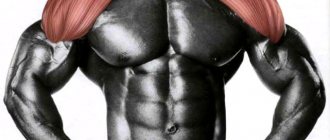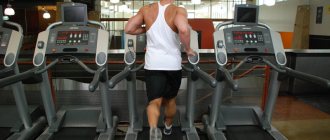Splits are not just a spectacular pose, but also beneficial for the body. Despite the fact that it is considered the prerogative of only ballerinas and gymnasts, mere mortals often want to master this rather difficult position. No one will be able to do the splits without preparation, and even if they succeed, a very dangerous injury is possible, so initially you need to work on stretching. Some people are naturally good at it, some, for example, the same ballerinas and gymnasts, diligently train it since childhood, and some people, not for nothing, consider themselves to be “wooden”, since they are not good at stretching. But even the latter can achieve excellent flexibility; all this is a matter of time and diligence. And a proper warm-up for the splits helps with this, the importance of which cannot be underestimated.
Why do you need a warm-up before the splits?
You need to understand that warming up before doing the splits is a must! Without it, you risk serious injury, and it also helps improve strength. The importance of warming up before doing the splits can be compared to the importance of washing your hands before eating. In the absence of this, unpleasant consequences are possible. The warm-up for the split stretch must be done, and done correctly. In addition to your safety, it will help you do the splits faster, although it is worth noting that rushing here may be inappropriate.
Warming up before stretching has the following benefits :
- improves muscle plasticity;
- improves blood circulation and saturates muscles with oxygen, and the latter in turn minimizes the amount of lactic acid;
- increases flexibility of joints and tendons;
- significantly reduces the risk of injury;
- increases the performance of muscle fibers.
Please note that warming up before the splits is necessary even for those who can already do the splits without any problems. And those who are just taking steps towards this goal should pay maximum attention to it. In order for the muscles to warm up and joint stiffness to go away, just ten minutes of preparation is enough. In addition, you need to take care of the cool-down: finish the exercise with relaxing movements and a light muscle massage.
The essence of the process
Great flexibility is possible for everyone. Some people reach a good stretch sooner, while others have to sweat a little. In any case, with good effort, you can always achieve the desired result.
In addition, the accompanying stretching exercises significantly improve blood circulation in the hip and abdominal parts, ligaments and joints. This promotes active intestinal function, improved posture, burning fat in the abdomen and hips, easier learning of various dances, and exercises prevent varicose veins or reduce the intensity of the development of the disease.
Trained muscles are able to withstand any load, their strength increases, which significantly reduces the risk of muscle tissue rupture. Do not focus on how to do the splits quickly, otherwise you will only harm yourself. Comprehensive, slow and calm training will surely lead you to your goal.
Exercise machine for weight loss at home
Read with the article
Exercise machine for weight loss at home
close
open
x
The process of stretching muscles is somewhat painful, so it requires a careful approach. Listen to your feelings - any crunches or excessive pain are unacceptable. Muscle tension should be natural. Continue stretching until you feel confident that you are ready to do the splits.
Warm-up for splits: indications and contraindications
With any physical activity, it is extremely important to consider your body's starting state and give it a load that it can handle. In order for training aimed at doing the splits to be effective and safe, the muscles and joints must be prepared for the upcoming loads.
If muscles are not used during everyday movements, the body becomes weaker. To prevent this, you need to stress absolutely all the muscles and joints of the body. The ability to do the splits is precisely an indicator of excellent health of the ligaments and joints.
It’s not for nothing that splits are included in many programs of therapeutic and preventive physical education. This type of stretching can be used by both absolutely healthy people and those who have medical indications . The list of the latter includes the following:
- Lack of abdominal muscle tone, need for stimulation of internal organs.
- Compensation for overexertion due to lack of mobility and inactive lifestyle.
- Low level of mobility of the hip joints, caused by trauma in the past.
Not everyone can do the splits. Contraindications in this case include injuries and inflammatory processes in the knees, ligaments and tendons of the groin, spinal injuries, abnormalities of the hip joints, as well as exacerbation of gynecological diseases.
Basic Rules
Before you begin doing stretching exercises for the splits, familiarize yourself with the basic rules of stretching training. These rules cannot be neglected; this is fraught not only with wasted time, but also with the risk of injury.
- In principle, by systematically performing stretching exercises, you can do the splits in any physical form - both with significant excess weight and with underdeveloped muscles. However, the ability to do the splits will not add many points to your image if your form leaves much to be desired. Therefore, it is recommended to give priority attention to achieving normal weight and other physical parameters, and only after that master the splits.
- Stretching is not a strength load, and you don’t need to give your muscles time to recover after it. The more often you practice, the sooner you will be able to do the splits. The ideal training regimen to strive for is two 20-minute stretching sessions daily, morning and evening. Remember that a day without training is a step back.
- You can only stretch warmed muscles, so before each workout you need a 10-minute warm-up - jumping, squats, running with high knees. Or do stretching exercises immediately after strength training or cardio.
- If you warm up your bottom with a hot shower or bath before stretching, the process will go much faster, and the goal of doing the splits in a month may be quite achievable.
- Perform the exercises smoothly, without jerking or sudden pain. Pain will inevitably be felt, but it should be tolerable.
- To avoid injury, it is better to do without the help of a partner, or at least agree that he immediately stops using force at your first request.
- The muscles being stretched should be as relaxed as possible and breathing should be calm.
- It is most convenient to practice on a bare, smooth floor wearing socks, which ensures good gliding.
- Having reached maximum stretching, it is advisable not to freeze in a static position, but to make oscillatory movements with small amplitude, strengthening and weakening muscle tension.
Contraindications to mastering the twine are injuries to the joints and spine, arthrosis, arthritis, osteochondrosis and other diseases of the musculoskeletal system, thrombosis, hernias of the groin and abdominal wall, arterial hypertension.
Secrets of training effectiveness
Initially, the warm-up before stretching into the splits, as well as the splits pose itself, should assume the correct starting position. The legs should be spicy, the heels should rest on the floor. The body should not bend, and both hands should take part in the safety net.
A warm-up for stretching should begin with actively warming up the muscles for ten minutes. This can be, in fact, any active exercises before the main stretching, preparing the body for training. You can alternate between jumping, running in place and squats, which help work all muscle groups and prepare them for stretching. Mages with legs forward, backward and to the sides also work well. Watch your body position and straight posture - let the amplitude of the swings increase gradually.
There are general rules on which a splits warm-up for beginners at home should be based:
- It is better to exercise in the evening . In the afternoon, the muscles are better ready for stretching than in the morning.
- The ideal option is to practice in front of a mirror and with a partner. It should help you keep your balance and rise, connect with your body position and a straight back, help fix your body and increase resistance. A mirror is necessary so that you can control your position and, if necessary, immediately correct mistakes.
- Exercise every day. It is better for the splits warm-up for beginners to be short, but regular, rather than long, but from time to time.
- Remember the rule of gradualism. Increase the range of movements slowly so that the load brings pleasant fatigue. Pain may be present, but it should be within reason.
- When trying to do the splits, you need to lean on your hands. This will ensure a smooth stretch and help avoid jerking.
- For beginners, it is better to start with cross splits - it is much simpler. It is better to move on to the longitudinal one when the muscles and connections have already acquired the necessary plasticity.
- An effective warm-up before stretching for beginners can include squats, body bends, lunges, rolls, plie exercises - a deep squat with the center of gravity transferred from one leg to the other.
- After you have already managed to do the splits, do not stop the exercises, otherwise the muscles will lose their acquired elasticity, and deep stretching will again become problematic for you.
Note
How to inflate a bicycle wheel and what pressure should be How to adjust the brakes on a bicycle
Every attempt to do the splits will be accompanied by muscle tension, which prevents sprains. With this in mind, do not focus on excessive stretching of the muscles, allow yourself to relax, concentrating on your own breathing, and focus on pleasant thoughts. As soon as you feel as positive as possible, begin rolling from your toes directly to your heels, gradually lowering into the splits. The first two approaches involve light training, then gradually add effort, and finally you can linger for a certain time at the “painful” point. Swing, move and rise.
It's time to give your best. Get help from someone who can apply pressure to your hips. Do not forget to be careful, the pain should not be critical, otherwise you will harm yourself.
Harmonious actions and setting reasonable goals are the key to your success in the task you have set for yourself: how to do the splits. You will succeed!
Stretching exercises before cross splits
Warm-up for cross splits may include the following exercises :
- Bend forward, in which your back should be straight and your hands should touch the floor.
- Squats with forward lunge. Keep one leg bent at the knee in front, the other straight behind. In this position you need to sit as deeply as possible.
- Squats-lunges, side rolls. The body weight should be alternately transferred from one leg in a bent position to the other.
- Taking a sitting position on the floor, spread your legs as wide as possible. Keep your back straight. You need to clasp your ankles with your hands and pull your chest down towards the floor.
- Place your feet shoulder-width apart, knees out to the sides. Squat as deeply as possible, while keeping the center of gravity of the body above the heels. Alternately shift the weight of your body from one leg to the other. Leave one leg bent at the knee, stretch the other to the maximum.
- Taking a sitting position on the floor, spread your legs as wide as possible, keep your back straight. Join your hands and stretch them forward until your chest touches the floor.
- Spread your legs as wide as possible, bend your arms slightly at the elbows, place them on the floor. It is important to correctly distribute your body weight between your elbows and heels and sit as low as possible until mild pain appears.
Try to hold each position for at least 30 seconds .
Note to parents: split stretching exercises for children
Longitudinal twine stretch
Warming up before the splits at home will be slightly different if the splits are longitudinal. Several other muscle groups will be involved here. We remind you that the longitudinal split is more difficult, so it should only be attempted by those who already have a certain level of training. A stretching warm-up in this case may include the following exercises :
- Lunge in runner's position at the start. The right leg should be bent at a right angle and placed in front. Keep your palms resting near your feet, your extended left leg behind you. Keeping your back straight, try to pull your left heel back as much as possible.
- From the previous position, relax your supporting left knee and rest it on the floor, stretch your feet. Hands need to be moved to the left, elbows placed on the floor. Move your right working knee to the side.
- Stand on your left knee, keeping your body straight. Extend your right leg with your foot pulled towards you, keep your hips straight. Place your hands on the floor, and while inhaling, straighten your shoulders and chest. Exhaling, bend down without bending your back.
- From the previous position, return to a lunge on your right leg, placing your palms on your sacrum. Lower your shoulder blades, bend back, and move your head back too.
- Get into a position on all fours. Extend your right knee until it touches your right wrist. Keep your hips straight. Move your right shin towards the left side of your pelvis and extend your left leg back. Without leaning forward, lower your pelvis as low as possible, pressing your hands to the floor and stretching your waist.
- Stand on your left knee with your right working leg extended forward. Place your hands on the floor, your shoulders and pelvis should be parallel to the floor surface. You need to slide your right foot forward while simultaneously stretching your left leg back. Make sure your back is as straight as possible.
Each exercise should be done with alternating legs. Try to hold the poses for at least 30 seconds.
The presented exercises are suitable both for those who are just trying to do the splits, and for those who can already cope with it. They will help work out ligaments and joints, improve flexibility and stretching. Perform them regularly, trying to stretch harder each time, but controlling the load so as not to provoke severe soreness and injury. A proper warm-up before stretching the splits, the video of which will tell you more about it, will help you achieve your goal.











